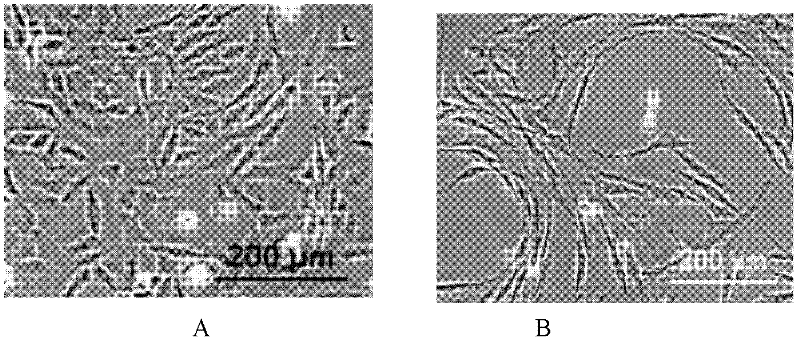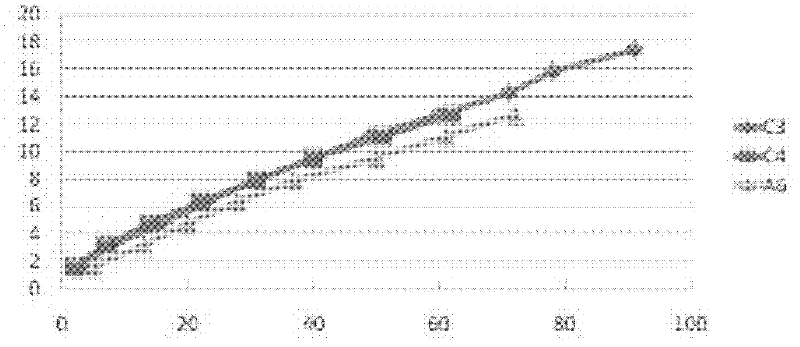Separation culture method for cartilage stem cells
A technology of chondrocytes and stem cells, applied in the direction of bone/connective tissue cells, animal cells, vertebrate cells, etc., can solve the problems of no sorting process, cell aging, limited quality, etc., and achieve high purity, accurate definition, and good expansion. empowering effect
- Summary
- Abstract
- Description
- Claims
- Application Information
AI Technical Summary
Problems solved by technology
Method used
Image
Examples
Embodiment 1
[0031] Example 1 (the reagents in this example were purchased from Invitrogen Company except for special instructions):
[0032] 1) Chondrocyte culture: take 0.20g of cartilage tissue (discarded tissue, donated by Sir Run Run Shaw Hospital Affiliated to Zhejiang University School of Medicine), cut it into 1mm×1mm×1mm pieces, PBS buffer (containing 100U each of penicillin and streptomycin) / mL) after washing, single chondrocytes were isolated under sequential digestion with hyaluronidase and type II collagenase. Filter, centrifuge at 1500r / min for 5min with a centrifugal radius of 4.5cm, and wash the precipitated cells twice with PBS. Low-sugar DMEM (20% FBS) to make cell suspension, with 10 cells / cm 2 Density inoculation in 10em culture dish, medium change once every 3d, 0.25% trypsin-EDTA for subculture, in vitro monolayer culture, low sugar DMEM (10% FBS) to the third generation.
[0033] 2) In vitro monolayer culture and CD146 immunofluorescence staining.
[0034] The in...
Embodiment 2
[0042] Example 2: The three-lineage differentiation ability of the cells obtained in Example 1 was identified.
[0043] (1) Identification of skeletal differentiation:
[0044] Induction process: cartilage stem cells were injected at 100 cells / cm 2 Inoculate with a 24-well culture plate, using osteoinductive medium (solvent: H-DMEM, add: 10% FBS, 100U / ml penicillin, 100U / ml streptomycin, 50μM ascorbic acid, 10mM β-sodium glycerophosphate, 0.1uM ground dexamethasone) for 14 days.
[0045] Osteogenic differentiation identification results: positive expression of ALP alkaline phosphatase (see Figure 6 A)
[0046] (2) Identification of adipose differentiation:
[0047] Cartilage stem cells were harvested at 100 cells / cm 2 Inoculated with 24-well culture plate, using adipose induction medium (solvent: H-DMEM, added: 10% FBS, 100U / ml penicillin, 100U / ml streptomycin, 0.5mM 3-isobutyl-1-methyl ( IBMX), 10uM insulin, 0.5uM dexamethasone) were induced for 14 days.
[0048] Adip...
Embodiment 3
[0052] After culturing the cells obtained in Example 1 and the existing bone marrow-derived mesenchymal stem cells to full growth, plant 2.5×10 6 Cells (50ul, 5×10 7 / ml) in sodium alginate gel to construct tissue engineered bone.
[0053] 1) Cells were marked with Dil fluorescent dye, implanted into the vacancy of the scaffold material, the cell and material complex was wrapped with sodium alginate gel, BMP4 was added as an osteogenic induction factor, and implanted subcutaneously in nude mice.
[0054] 2) Take it out after 8 weeks, track its fluorescence, and observe the cell survival, which shows that the cell survival is good. Cartilage stem cells (CSPC) were superior to bone marrow-derived mesenchymal stem cells (BMSC) by X-ray detection of calcification. The comparison results of cartilage stem cells and MSCs in vivo osteogenic ability are shown in Figure 7 , suggesting that it has better ectopic osteogenesis ability.
PUM
 Login to View More
Login to View More Abstract
Description
Claims
Application Information
 Login to View More
Login to View More - R&D
- Intellectual Property
- Life Sciences
- Materials
- Tech Scout
- Unparalleled Data Quality
- Higher Quality Content
- 60% Fewer Hallucinations
Browse by: Latest US Patents, China's latest patents, Technical Efficacy Thesaurus, Application Domain, Technology Topic, Popular Technical Reports.
© 2025 PatSnap. All rights reserved.Legal|Privacy policy|Modern Slavery Act Transparency Statement|Sitemap|About US| Contact US: help@patsnap.com



